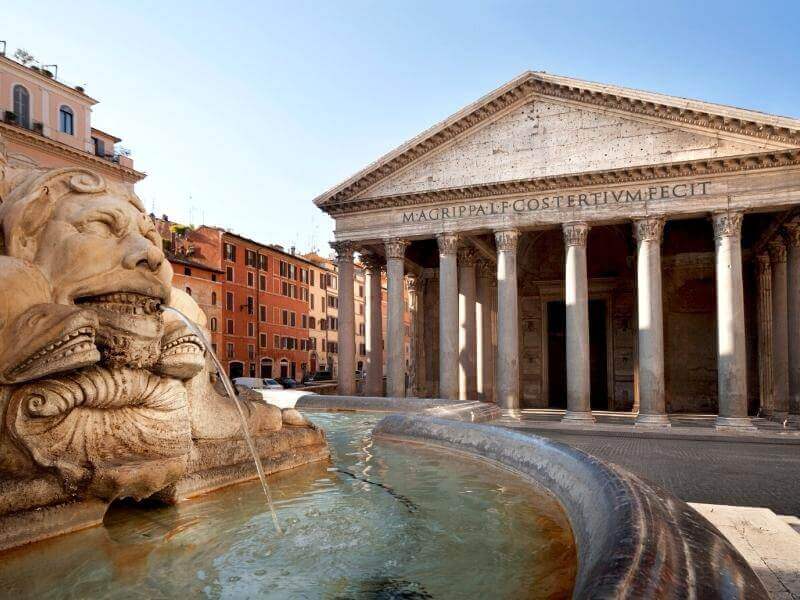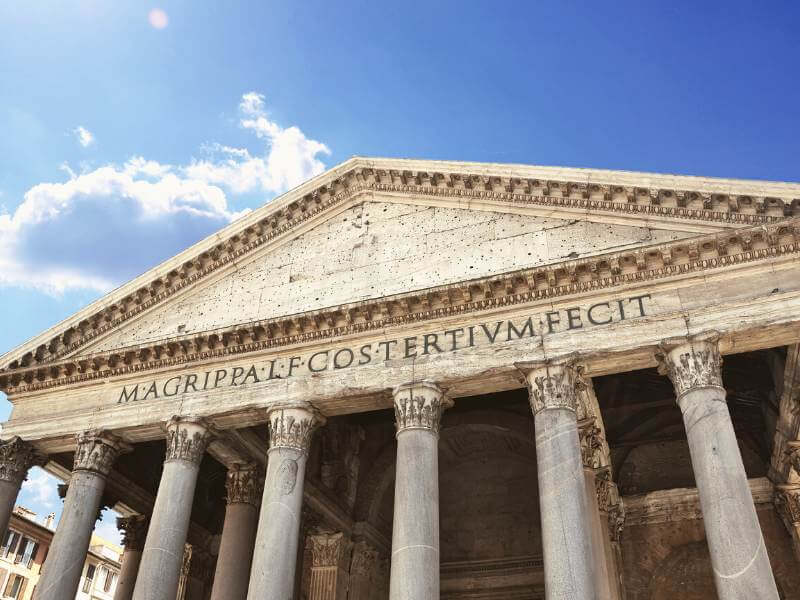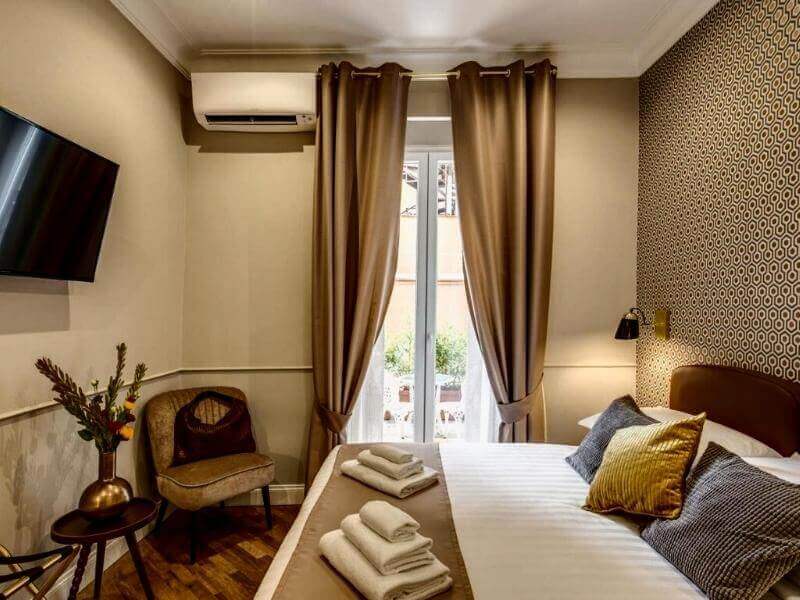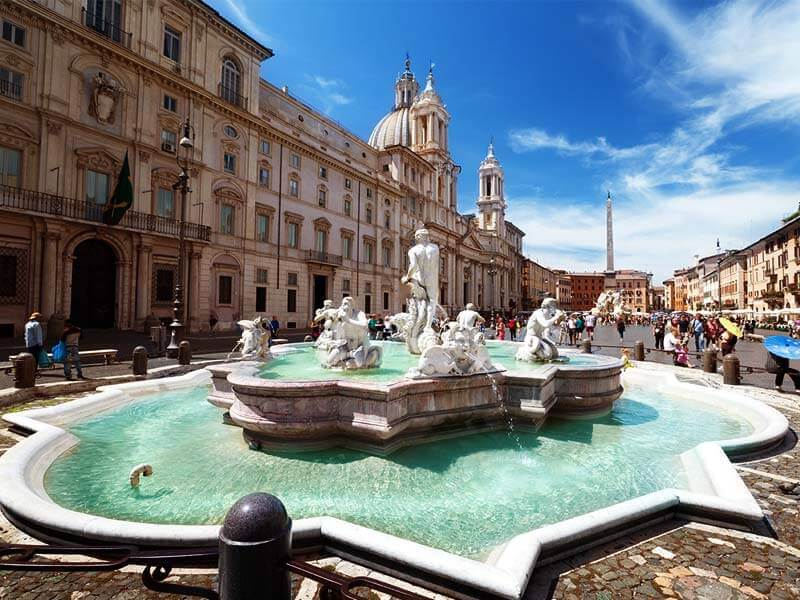The Pantheon in Rome, Italy: History & Visitor Information
Home » Attractions » Pantheon
| DE

- - Updated on
With its 2000 years of history, the Pantheon (Latin: “pan” = all, “theos” = gods) is by far the oldest and, at the same time, one of the best-preserved attractions in Rome.
About 7 million tourists visit Piazza della Rotonda annually to get an impression of this stunning Roman architecture. The Latin bronze inscription below the pediment, “M.AGRIPPA.L.F.COS.TERTIUM.FECIT,” still refers to the builder of the monument at that time.
This means that “Marcus Agrippa, son of Lucius, built this temple when he was consul for the third time.” The construction of the present church was completed in 27 BC.

A fire in 80 AD damaged the temple so much that it had to be restored by Emperor Domitian until another fire was caused by a lightning strike in 110 AD.
Finally, it was Emperor Hadrian who had the current version of the Pantheon rebuilt between the years 120 – 125 AD. All the more astonishing is that he had Marcus Agrippa’s inscription affixed as the original builder of the temple.
Visitor Information:
Address:
Piazza della Rotondo, 00186 Roma
Transportation:
Metro Line A, Metro station: Barberini
Opening hours:
Monday to Saturday from 9:00 am to 19:00 pm
Sundays from 9:00 am to 18:00 pm
Public Holidays from 9:00 am to 13:00 pm
Closed on the following days: January 1st| May 1st | December 25th
No access during masses (Sundays at 10:30 am and Saturdays at 17:00 pm)
Nearby:
Piazza Navona (0,3 km)
Trevi Fountain (0,6 km)
Spanish Steps (1,1 km)
Roman Forum (1,1 km)
Palatine Hill (1,1 km)
Castel Sant Angelo (1,2 km)
How long to visit:
1-2 hours
Admission to the Pantheon costs since July 2023!
Our tip: With the Rome Tourist Card, you get an Audioguide for the Pantheon, as well as admission to the Colosseum, St. Peter’s Basilica, Roman Forum & Palatine, and priority admission to the Vatican Museums & the Sistine Chapel!

Pantheon Rome History: From a temple to a church
On November 1, 609, Pope Boniface IV transformed the former temple into a church. He consecrated it to the Madonna and all the holy martyrs and gave the church the name “Santa Maria ai Martiri.”
By the way, today’s “All Saints’ Day” holiday goes back to this day! Over time, significant looting occurred again and again. For example, the gilded bronze roof tiles of the building had to give way, as well as the beautiful marble cladding of the building.
It is said that Pope Urbanus VIII had the bronze roof tiles of the Pantheos melted down, thereby casting the canopy over the tomb of Peter in St. Peter’s Basilica.


Awe-inspiring are the many tombs and altars inside the monument. During the 16th century, the Pantheon in Rome also developed into the Church of the Holy Sepulchre.
Among other things, Italian kings, as well as artists, were buried here. The following list shows only some of these significant personalities.
The Pantheon in Rome is the tomb of:
- King Vittorio a Emanuele II.
- Emperor Umberto I
- Renaissance artist Raphael
- Composer Arcangelo Corelli
- Cardinal Ercole Consalvi
- ……
Our hotel recommendations near the Pantheon:
Have you already found a suitable hotel?
We have researched the best hotels nearby! -> Hotels in Rome City Center
The Dome of the Pantheon
Until recently, civil engineers worldwide wondered how the Romans managed to build the “Rotonda,” or dome of the Pantheon, so huge.
With its enormous diameter of 43.20 meters and a height of 23 meters, it is a true feat of antiquity and even more significant than the St. Peter’s Basilica dome.

Leading architects believe such a massive, self-supporting concrete dome could only be replicated today with sophisticated computer measurements.
The dome is divided into 5 rings and 28 cassettes each and has a circular opening with a diameter of 9 meters. What meaning this might have had is partially clear to this day.
It is speculated that it served as a sundial, which indicates the season due to the different light irradiations. Besides the entrance to the Pantheon, the dome is the only source of light in the ancient building.
Depending on the time of day and season, different points of the room are illuminated, which makes the building truly unique. Click here to visit the official website of the Pantheon!
On the map, you can see the location of the Pantheon:
The Pantheon is located near Piazza Navona. This is one of the most beautiful squares in Rome and is ideal for taking a break. There are many places to eat here, including restaurants, sidewalk cafes, and delicious ice cream parlors!

Editor: Sebastian Erkens
Hey and welcome to Rome-Tourist! My name is Sebastian and I travel regularly to Rome, Italy.
On our Rome blog you will get valuable travel tips. If you have any questions about specific tours or sights, feel free to leave us a comment.
These articles may also interest you:




